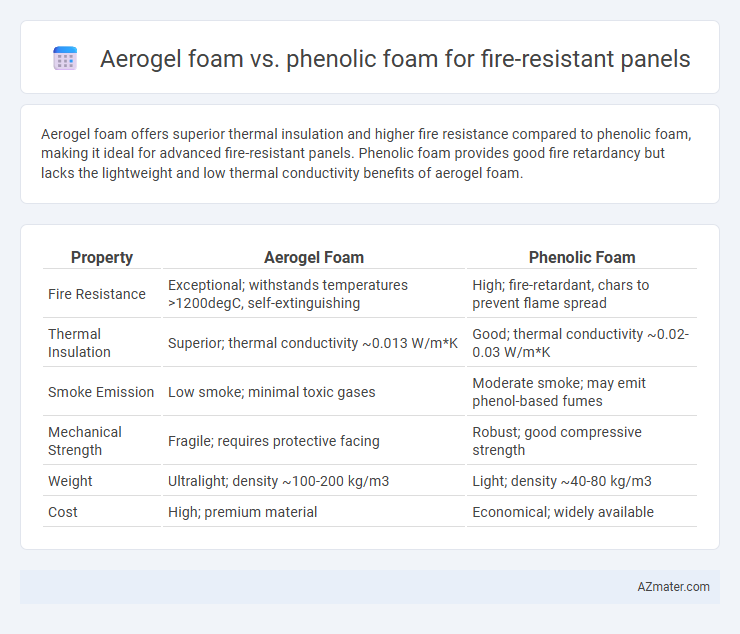Aerogel foam offers superior thermal insulation and higher fire resistance compared to phenolic foam, making it ideal for advanced fire-resistant panels. Phenolic foam provides good fire retardancy but lacks the lightweight and low thermal conductivity benefits of aerogel foam.
Table of Comparison
| Property | Aerogel Foam | Phenolic Foam |
|---|---|---|
| Fire Resistance | Exceptional; withstands temperatures >1200degC, self-extinguishing | High; fire-retardant, chars to prevent flame spread |
| Thermal Insulation | Superior; thermal conductivity ~0.013 W/m*K | Good; thermal conductivity ~0.02-0.03 W/m*K |
| Smoke Emission | Low smoke; minimal toxic gases | Moderate smoke; may emit phenol-based fumes |
| Mechanical Strength | Fragile; requires protective facing | Robust; good compressive strength |
| Weight | Ultralight; density ~100-200 kg/m3 | Light; density ~40-80 kg/m3 |
| Cost | High; premium material | Economical; widely available |
Introduction to Fire-Resistant Panel Materials
Aerogel foam and phenolic foam are advanced materials commonly used in fire-resistant panels due to their excellent thermal insulation and flame retardant properties. Aerogel foam offers superior thermal resistance with low thermal conductivity around 0.013 W/m*K, making it highly effective for extreme fire protection and energy efficiency. Phenolic foam provides robust fire resistance through its char-forming ability, low smoke emission, and thermal conductivity approximately 0.020 W/m*K, often favored for cost-effective and high-performance fire-rated panel applications.
Understanding Aerogel Foam: Composition and Properties
Aerogel foam, composed primarily of silica-based nanoparticles forming a porous matrix, exhibits exceptional thermal insulation and fire-resistant properties due to its low density and high surface area. Its unique structure enables superior heat resistance and minimal thermal conductivity compared to phenolic foam, which is based on thermosetting resin and offers moderate fire resistance and mechanical strength. Understanding aerogel foam's composition highlights its advantages in fire-resistant panel applications, including enhanced thermal stability and lighter weight, making it preferable for advanced insulation solutions.
What is Phenolic Foam? Structure and Fire Resistance
Phenolic foam is a rigid cellular insulation material composed of phenol-formaldehyde resin with a closed-cell structure, providing excellent thermal insulation and dimensional stability. Its tightly cross-linked network enhances fire resistance by producing minimal smoke and low heat release during combustion, meeting stringent fire safety standards. Phenolic foam's inherent flame-retardant properties make it a preferred choice for fire-resistant panels in building and industrial applications.
Thermal Insulation Performance: Aerogel vs Phenolic Foam
Aerogel foam exhibits superior thermal insulation performance compared to phenolic foam, boasting thermal conductivities as low as 0.013 W/m*K, which enhances fire-resistant panel efficiency by minimizing heat transfer. Phenolic foam, while effective with thermal conductivity around 0.02 W/m*K, offers less insulation efficiency but compensates with excellent fire retardant properties and smoke suppression. The low density and nanoporous structure of aerogel foam contribute to its outstanding insulation, making it ideal for high-performance fire-resistant panels in demanding thermal protection applications.
Fire Resistance Comparison: Aerogel Foam vs Phenolic Foam
Aerogel foam exhibits superior fire resistance with a high melting point above 1,200degC and low thermal conductivity around 0.013 W/m*K, effectively insulating against extreme heat. Phenolic foam also offers excellent fire resistance, featuring low smoke emission and self-extinguishing properties, but typically has a lower thermal stability, degrading around 250degC to 300degC. The enhanced thermal stability and insulating performance of aerogel foam make it more effective for high-temperature fire-resistant panel applications compared to phenolic foam.
Weight and Density Analysis in Panel Applications
Aerogel foam offers significantly lower density, typically around 0.02 to 0.1 g/cm3, compared to phenolic foam's density range of 0.16 to 0.32 g/cm3, making it highly advantageous for lightweight fire-resistant panels. The ultra-low weight of aerogel foam reduces overall panel mass without compromising thermal insulation or fire resistance, crucial for aerospace and high-performance building applications. Phenolic foam's higher density contributes to mechanical strength but results in heavier panels, impacting ease of installation and structural load considerations.
Durability and Longevity of Aerogel and Phenolic Foams
Aerogel foam exhibits superior durability and longevity compared to phenolic foam due to its low thermal conductivity and resistance to high temperatures without significant degradation. Phenolic foam, while effective as a fire-resistant material, tends to become brittle and lose structural integrity over extended exposure to heat and environmental factors. The extended lifespan of aerogel foam in fire-resistant panels ensures sustained protection and reduced maintenance costs in demanding applications.
Environmental Impact and Sustainability Considerations
Aerogel foam offers superior thermal insulation with lower density and longer lifespan, reducing material waste and energy consumption compared to phenolic foam, which relies on petroleum-based resins that generate higher VOC emissions and pose recycling challenges. Phenolic foam has moderate biodegradability but exhibits a higher environmental footprint due to its production involving formaldehyde and phenol derivatives, impacting air quality and disposal processes. Aerogel's non-toxic composition and potential for reuse align better with sustainable building practices, enhancing fire-resistant panel performance while minimizing ecological impact.
Cost and Availability of Aerogel vs Phenolic Fire-Resistant Panels
Aerogel foam fire-resistant panels typically have a higher cost due to advanced manufacturing processes and premium raw materials, while phenolic foam panels are more economical and widely accessible because of established production methods. Availability of aerogel panels is limited, often requiring specialized suppliers and longer lead times, whereas phenolic foam panels are readily available through numerous manufacturers globally. The price premium for aerogel is balanced by superior thermal insulation and fire resistance properties, but phenolic remains the cost-effective choice for large-scale, budget-conscious fire-resistant panel projects.
Conclusion: Choosing the Right Foam for Fire-Resistant Panels
Aerogel foam offers superior thermal insulation and higher fire resistance compared to phenolic foam, making it ideal for applications requiring maximum protection and energy efficiency. Phenolic foam provides excellent fire retardancy with cost-effective manufacturing but may fall short in extreme temperature scenarios and long-term durability. Selecting the right foam depends on balancing budget constraints, insulation performance needs, and fire safety standards specific to the intended use of the fire-resistant panel.

Infographic: Aerogel foam vs Phenolic foam for Fire-resistant panel
 azmater.com
azmater.com